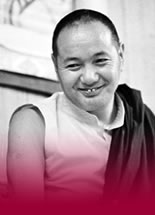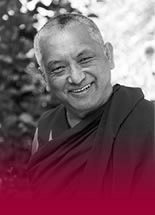Q & A with Robina

A rock painted with mantras near Swayambhunath Stupa in Kathmandu. Photo: Ven. Katy Cole.
23 September, 2019
QUESTION
Dear precious Robina,
I'm sure you're fine, as I am too!
I have a question for you. Whenever I read the Prajnaparamita Sutra, I remember at a retreat you mentioned something about, “Form is empty. Emptiness is form,” and that it’s not literally correct.
But, of course, my pathetic mind cannot remember... Would you kindly refresh this poor mind with the shower of your kind wisdom?
Huge hugs, big love
ANSWER
Happy to hear from you, dearest one! Yes, I am fine.
You’re right: His Holiness says that it’s not actually true that “emptiness is form . . . form is nothing other than emptiness and emptiness is nothing other than form.”
So, what it means is this. Every conventional phenomenon — such as tables and chairs and people and, as it says in the Heart Sutra, form, which is one of the aggregates — just naturally is empty of inherent existence, as we know.
His Holiness says that when it says in the Heart Sutra that —
Form is empty.
Emptiness is form.
Form is nothing other than emptiness.
And emptiness is nothing other than form.
— it’s to make it clear that emptiness does not mean nothingness; that we don’t fall into the abyss of the great mistake, as Lama Tsongkhapa puts it.
In other words, wherever you will find the conventional phenomenon called form, right there you will find the emptiness of inherent form. In other words, emptiness of inherent form is a characteristic of form.
In other words, wherever there is form there is emptiness of inherent form, and wherever there is emptiness of inherent form, there is form.
You could just as easily say
JP is empty (of inherent existence).
Emptiness (of inherent JP) is (conventional) JP.
(Conventional) JP is nothing other than emptiness (of inherent JP).
And emptiness (of inherent JP) is nothing other than (conventional) JP.
In other words, you cannot have one without the other.
Wherever there is JP you will always find the emptiness of inherent JP right there.
The two truths together, in other words.
Love to you,
Robina
QUESTION
Zillions of thanks for your kind explanation, which is crystal clear!
All the very best,
JP

